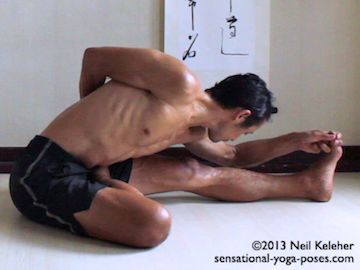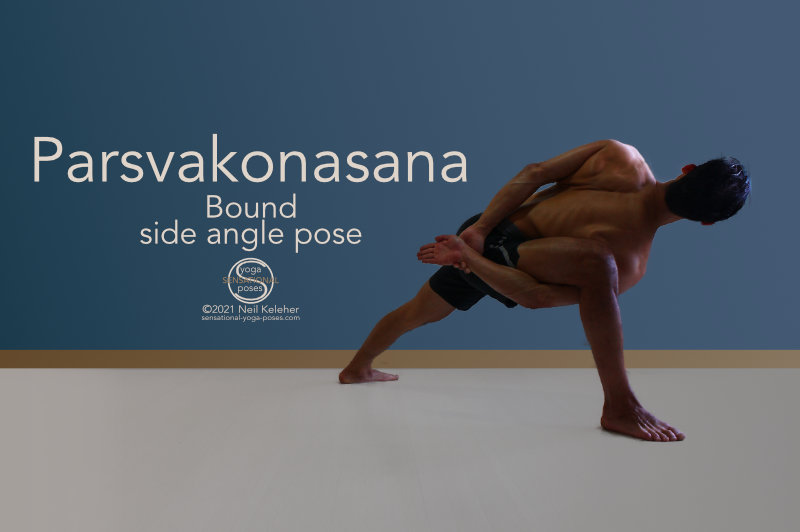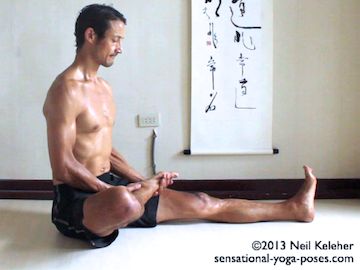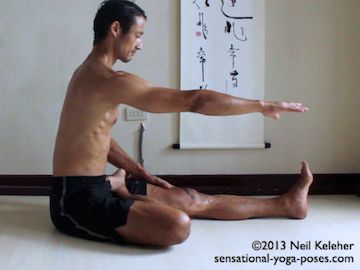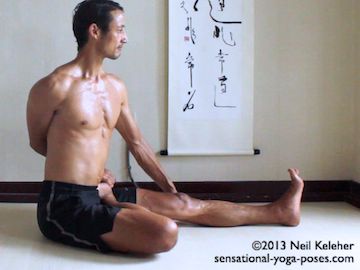Binding in Seated Half Bound Lotus Pose
Steps for Binding in Seated Half Bound Lotus Pose as well as modifications if you can't bind
In seated half bound lotus, the binding action is similiar to that used in bound side angle pose. However, in the half bound lotus binding yoga pose you bind by grabbing the foot from behind the back as opposed to the hand.
Compare the right hand in bound side angle and bound half lotus.
In both cases the arm reaches behind the back, however in side angle the arm wraps around the thigh.
Setting Your Lotus Leg Up for Binding
To bind in half lotus forward bend (the seated version) try to get your lotus foot onto the top of your other thigh with the center of the back of the foot on the center line of the thigh.
Work at pulling the foot back into the crease of the thigh.
As you are pulling your foot into lotus you may find it helpful to resist by trying to push your shin forwards. Resist as you gently pull your foot back into lotus.
If this causes knee pain (or any other kind of pain) then stop pulling.
For myself, I find that when I push forwards with the shin it sometimes (not all times) makes the knee feel more integrated. However, when I do pull forwards I apply the pressure gradually. And I pull the foot back gradually, mindfully.
Creating Length In Order to Bind
When binding in lotus I like to reach the binding arm forwards first. I make it feel long. This is similiar to binding in Modified Marichyasana B. Then I reach it out to the side and then back, keeping the arm feeling long at all times. As I reach it back I internally rotate.
Using the Other Hand If You Can't Bind!
If I can't grab the foot then I'll hook the foot with the fingers of my other hand. If my right foot is in lotus, then I'll hook it with my left hand and then reach the thumb of that hand backwards. I'll then grab on to the thumb with the right hand and then from there.
If that's as far as you can go, then just stay there, but other wise you can use your left hand to help your right hand grab the foot and bind.
Another option is to hook the foot with the left hand, then with the right hand grab onto the upper arm of the left arm. You can still get a similiar affect to binding. Pull your foot forwards, as it trying to pull away from your hand. Pull back with your hand, and in turn pull on the upper arm of that hand with the hand that should be binding.
After You've Bound
Once you've grabbed the foot, keep your grip strong. You can pull the foot forwards and at the same time pull the shoulder back.
Lengthen your neck and if you like tilt forwards.
If bending forwards causes your lotus knee to hurt, then don't do it.
Optionally, experiment with foot and ankle tension. Try pointing your foot or flexing it. Or try adjusting the positoin of your foot relative to your thigh. So in this case, rather than just not doing the pose, or rather than forcing yourself into the pose, experiment to see if you can find a foot position and/or foot action that makes your knee feel comfortable, even when binding forwards. But work carefully, and if nothing helps, then give up gracefully. Come back to it on another day, perhaps with a different approach.
More on Preparing for Lotus
For more instruction on preparing for the lotus foot position read half bound lotus yoga pose.
Published: 2017 11 15
Updated: 2020 10 29
